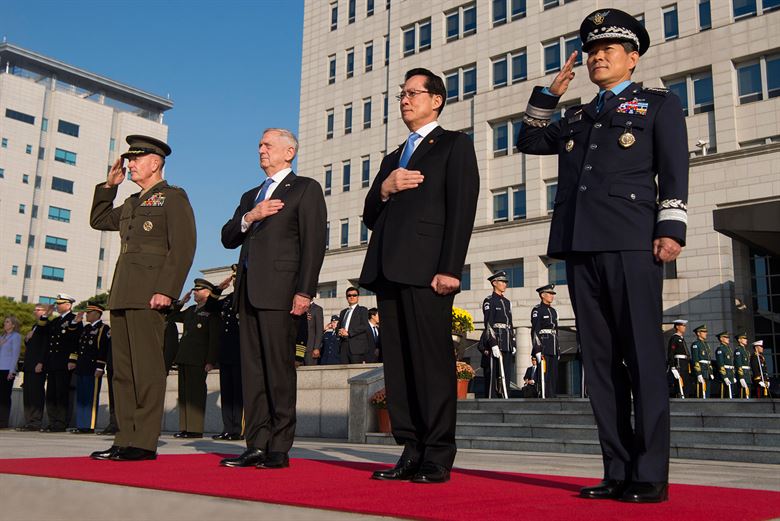Special to WorldTribune.com
 By Donald Kirk
By Donald Kirk
WASHINGTON – The U.S. and South Korea disagree markedly in their approach to North Korea and do not seem likely to patch up their differences any time soon.
The differences emerged sharply as the U.S. defense secretary, Jim Mattis, prepared to meet Korea’s defense minister Jeong Kyong-Doo for talks at which OPCON, operational control of allied forces in time of war, was sure to be a central issue.

The U.S. and South Korea have repeatedly postponed OPCON, which was originally to take effect in 2015 but was postponed to 2020 after both sides agreed South Korea was not yet ready to take full control if war broke out. Now they’re saying OPCON should be “condition-based” – that is, should take effect when North Korea no longer posed a significant threat. In any case, a South Korean general would be in overall charge.
Mattis and Jeong may come to a general understanding on OPCON, but it’s not likely Mattis is happy about the terms of an agreement reached between President Moon Jae-In and Kim Jong-Un on declaring a no-fly zone limiting the movement of military aircraft near the demilitarized zone between the two Koreans and also tearing down guard posts within one kilometer of either side of the DMZ.
The Americans are upset that they were not consulted on the deal since the U.S. and South Korea are still bound in a military alliance under the overall United Nations Command, formed at the outset of the Korean War.
Mattis wants to get down to practical problems with Jeong, reaching a clear understanding on where aircraft can go and what type of exercises can be staged in view of the agreement with North Korea. The U.S. evidently has no choice but to go along with the deal, however reluctantly, but officers want to develop a set of ground rules to be sure they know the exact terms and what their forces can and cannot do.
One of the Americans’ deepest concerns is that they have no way of checking on what the North Korean forces are also doing. The North has thousands of artillery pieces above the North-South line within range of Seoul and Incheon and several hundred thousand troops within 50 or 60 kilometers of the North-South line.
While Mattis pursues an understanding with South Korea on military planning, Secretary of State Mike Pompeo is hoping for another meeting with a top North Korean official, probably Kim Yong-Chol, vice chairman of the Workers’ Party, whom Pompeo has met on a number of occasions, both in Pyongyang and in the U.S. The goal of the meeting would be to see if he can finally work out conditions for another summit between President Donald Trump and Kim Jong-Un.
The North Koreans are believed to be demanding in advance that Trump agree that he will sign a “peace declaration” that would formally bring the Korean War to a close. Pompeo may want to discuss the terms of such a declaration, making clear that the U.S. would not commit to revising the treaty alliance with South Korea or to withdrawing its troops from South Korea.
He and Kim Yong-Chol might also discuss the venue for another Trump-Kim summit, possibly in Switzerland where Kim went to school, or even at Panmunjom, in one of the structures that straddle the North-South line.
Pompeo also is expected to convey to Kim Yong-Chol the U.S. demand that North Korea abandon its nuclear program as a prerequisite for the U.S. dropping sanctions. Moon has been calling for easing of sanctions, and his close adviser, Moon Chung-In, who went with him to his summit in Pyongyang, said the U.S. demand was not realistic.
South Koreans in Moon’s entourage have also been saying that it is unreasonable to keep insisting that North Korea provide an inventory of all its facilities, including nuclear warheads and missiles, where and how they’re made.
The North Koreans are adamant in their refusal to disclose these details, just as they insist on relief from sanctions and a “peace declaration” as important “corresponding measures” or conditions for taking other measures to bring about “denuclearization.”
Without falling into line behind these demands, the Americans are attempting to show that they and the South Koreans share common goals.
For instance, the new U.S. special representative for North Korea, Stephen Biegun, has been in Seoul repeating the usual litany of close cooperation in meetings with Moon’s top aides.
While the Americans are barely disguising their unhappiness with Moon’s policies, Biegun told South Korea’s unification minister, Cho Myoung-Gyon, that the U.S. and South Korea both “want the same thing” – namely “peace and stability primarily through denuclearization of North Korea.” Now, Cho responded, was a “very important time” for cooperating on “many initiatives.”
This kind of talk, though, barely disguised the fact that the Americans are quite worried about Moon’s approaches to North Korea – and are particularly upset that he should have made a military agreement with Kim Jong-Un without talking it over with South Korea’s defender and ally, the U.S.
